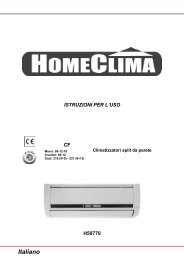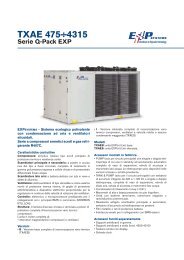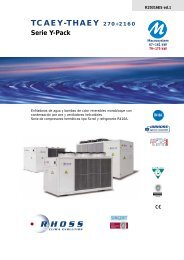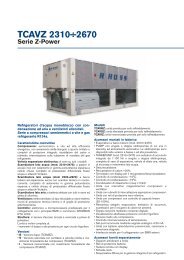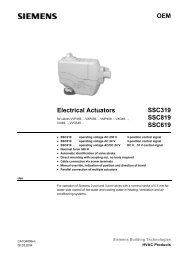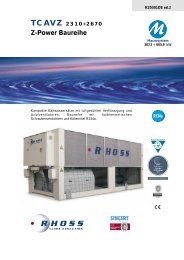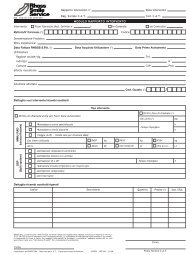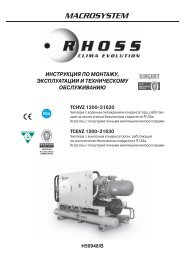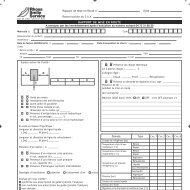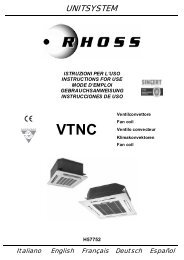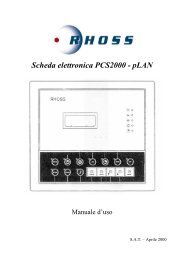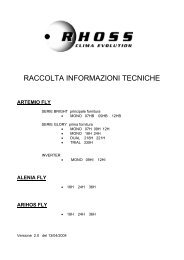SPLIT-SYSTEM - Rhoss
SPLIT-SYSTEM - Rhoss
SPLIT-SYSTEM - Rhoss
Create successful ePaper yourself
Turn your PDF publications into a flip-book with our unique Google optimized e-Paper software.
II.2.2<br />
SECTION II: INSTALLATION AND MAINTENANCE<br />
MAXIMUM DIFFERENCE IN HEIGHT<br />
BETWEEN THE UNITS<br />
The maximum permitted difference in height between the internal and<br />
external unit is +/- 5 m.<br />
When the difference in height between the internal and external unit<br />
exceeds 3 m and the external unit is positioned higher than the internal<br />
one, we recommend installing a siphon on the gas line in order to<br />
facilitate the return of the lubricant oil to the compressor (Fig. 2).<br />
The unit must not operate continuously in cooling mode in rooms with a<br />
high relative humidity (above 80%). In these conditions condensation<br />
could form on the mouth of the air outlet which could damage objects<br />
below it, or the floor, or the wall to which the unit is attached.<br />
II.1.3.2<br />
External Unit<br />
The external unit should be installed above ground, so that it is not<br />
easily accessible, on suitable brackets for supporting the weight of the<br />
unit and the connection pipes.<br />
Respect the technical spaces illustrated below.<br />
II.2<br />
INSTALLATION<br />
DANGER!<br />
Installation must only be carried out by skilled<br />
technicians, qualified to work on air conditioning<br />
and refrigerant systems.<br />
Incorrect installation could cause the unit to run<br />
badly, with consequent deterioration in<br />
performance.<br />
The unit must be installed according to national or<br />
local rules in force at the time of installation.<br />
Instructions for correct air conditioning unit installation are provided<br />
here.<br />
The completion of the operations on the basis of specific requirements<br />
is left to the experience of the installer.<br />
II.2.1<br />
NOISE AND VIBRATION REDUCTION<br />
Proper installation calls for measures aimed at reducing noise<br />
disturbances caused by the normal operation of the external unit.<br />
Before installing the unit, check with local authorities about the<br />
existence of specific limitations concerning permitted environmental<br />
noise.<br />
The external unit must never be located in areas where there are<br />
spaces which are normally inhabited (offices, living rooms, bedrooms<br />
etc).<br />
Particular attention should be paid to installations near rooms used by<br />
sick or disabled people.<br />
The use of antivibration mountings for the unit guarantees adequate<br />
absorption of vibrations transmitted to the building by the unit.<br />
Special measures must be taken if the unit is installed in an area with a<br />
high risk of earthquakes or in other particular situations. In these cases<br />
it is necessary to obtain the advice of specialized technicians.<br />
II.2.3<br />
INTERNAL UNIT INSTALLATION<br />
The internal unit must be wall-mounted.<br />
Respect the minimum clearance distances indicated.<br />
Before installing the unit, make some preliminary checks in order to<br />
ascertain that:<br />
• the wall where the unit is to be installed is solid and sufficiently level<br />
in order to provide a good support;<br />
• the minimum technical clearance distances can be respected for<br />
installation;<br />
• the unit will not be covered by curtains or other objects that disturb<br />
the ingoing and outgoing passage of air;<br />
• the unit, and consequently the receiver (infrared signal), will not be<br />
exposed to direct sunlight or electronic lights, which could prevent it<br />
from operating correctly;<br />
• the unit is not installed at a height above ground of more than 2.7<br />
metres in order to prevent air stratification effects during operation.<br />
Proceed as follows to install the unit:<br />
• fix the paper template provided to the wall selected;<br />
• using a drill with a small tip, mark the following centres: hole for the<br />
passage of the pipes and electric wires, hole for the expansion plugs for<br />
the fixture of the support plate (minimum No. 4, use others if<br />
necessary);<br />
• make the hole for the pipe and electric wire passage (Fig. 3);<br />
Internal wall<br />
side<br />
Internal wall<br />
side<br />
External<br />
wall side<br />
External<br />
wall side<br />
• make the holes for the expansion plugs;<br />
• remove the support plate fixed to the unit;<br />
• secure the support plate to the wall using the plugs and make sure<br />
that it is perfectly horizontal;<br />
• unscrew the screws that hold the unit casing in place;<br />
• bend the copper pipes on the back of the unit on the basis of<br />
requirements (Fig. 4);<br />
IMPORTANT!<br />
The copper pipes must be bent very carefully in<br />
order to avoid cracks occurring.<br />
Fig. 2<br />
Fig. 3<br />
31



